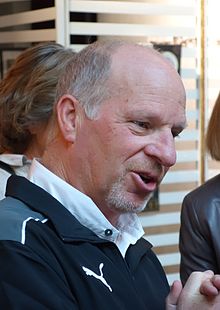Michael Houstoun
Michael Houstoun | |
|---|---|
 Michael Houstoun in 2013 | |
| Background information | |
| Born | 20 October 1952 Timaru, New Zealand |
| Genres | classical |
| Occupation | concert pianist |
| Instrument | piano |
| Website | www |
Michael Houstoun CNZM (born 20 October 1952) is a concert pianist from New Zealand. He has twice in his life performed the complete cycle of Beethoven sonatas and in between these achievements, he overcame focal hand dystonia.
Early life
Houstoun was born in Timaru in 1952.[1] His parents were Archie and Ngaire Houstoun. He received his education at Claremont Primary School and Timaru Boys' High School.[1] Houstoun started playing piano at the age of five and studied under Sister Mary Eulalie in Dunedin and, from age 15, Maurice Till in Christchurch.[1][2]
Career
Having won every New Zealand piano competition and award as a teenager, Houstoun then travelled and entered three major international competitions: Van Cliburn (1973, 3rd place), Leeds (1975, 4th place) and Tchaikovsky (1982, 6th).[3]
From 1974 to 1981 he studied at the Curtis Institute of Music in Philadelphia and London.[2] Houstoun returned to live in New Zealand in 1981; as of 2012[update] he lived in Feilding.[4] He regularly plays with New Zealand's professional music-ensembles as well as giving solo recitals and recording. Aged 40,[5] he performed and recorded the complete Beethoven-sonata cycle, and collaborated with Tainui Stephens on a television documentary about Franz Liszt entitled Icon in B minor.
In 1987 he launched the Kerikeri competition which became the Kerikeri International Piano Competition[6] in 2012, attracting outstanding pianists and teachers from around the world.
In 1999 Houstoun received an honorary doctorate in literature from Massey University. Houstoun started suffering from focal hand dystonia, which could easily have ended his career. The condition was treated with physiotherapy and acupuncture, and he had splints made, used rubber bands, and learned braille as sensory retraining, but Houstoun believes that his relaxation technique helped him overcome the condition.[7][8] In 2001 a documentary was filmed[by whom?] about his condition.[4] After five years he started performing again as a soloist.[4][8] In the 2012 Queen's Birthday and Diamond Jubilee Honours Houstoun was appointed a Companion of the New Zealand Order of Merit for services as a pianist.[4]
In 2013, he repeated his achievement from 20 years earlier of performing all 32 Beethoven piano-sonatas.[3][9]
References
- ^ a b c "Michael Houstoun". Timaru District Council. Archived from the original (PDF) on 27 February 2013. Retrieved 29 October 2013.
- ^ a b "Pianist's work honoured". The Timaru Herald. 4 December 2008. Retrieved 29 October 2013.
- ^ a b "Masterpieces come to life". Taranaki Daily News. 29 October 2013. Retrieved 29 October 2013.
- ^ a b c d Johnston, Alexia; Williams, Al (4 June 2012). "Our outstanding Kiwis". The Timaru Herald. Retrieved 29 October 2013.
- ^ Hannigan, Margot (21 August 2013). "Beethoven, Houston a treat for audience". The Nelson Mail. Archived from the original on 30 October 2013. Retrieved 29 October 2013.
- ^ "Archived copy". Archived from the original on 16 August 2018. Retrieved 10 August 2018.
{{cite web}}: CS1 maint: archived copy as title (link) - ^ Hickling, Alfred (9 March 2007). "Pain stopped play". The Guardian. Retrieved 29 October 2013.
- ^ a b Houstoun, Michael (20 November 2005). "Focal Dystonia — My History". Music and Health. Retrieved 29 October 2013.
- ^ Hannigan, Margot (24 October 2013). "Houstoun steeped in emotion". The Nelson Mail. Archived from the original on 30 October 2013. Retrieved 29 October 2013.
External links
- Use dmy dates from November 2012
- 1952 births
- Living people
- New Zealand classical pianists
- Male classical pianists
- People from Timaru
- Prize-winners of the Leeds International Pianoforte Competition
- Companions of the New Zealand Order of Merit
- People educated at Timaru Boys' High School
- Curtis Institute of Music alumni
- Massey University alumni
- 21st-century classical pianists
- 21st-century male musicians
